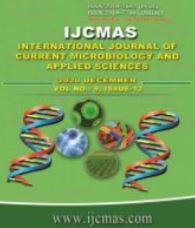


 National Academy of Agricultural Sciences (NAAS)
National Academy of Agricultural Sciences (NAAS)

|
PRINT ISSN : 2319-7692
Online ISSN : 2319-7706 Issues : 12 per year Publisher : Excellent Publishers Email : editorijcmas@gmail.com / submit@ijcmas.com Editor-in-chief: Dr.M.Prakash Index Copernicus ICV 2018: 95.39 NAAS RATING 2020: 5.38 |
Genetic Diversity Studies in Sesamum was carried for forty-two genotypes to study the nature and extent of genetic diversity for the characters viz; days to 50 % flowering, days to maturity, plant height at maturity (cm), number of branches per plant, number of capsules per plant, number of seeds per capsule, 1000 seed weight (g), oil content (%) and seed yield per plant (g). Analysis of variance revealed significant difference among the genotypes for all the characters. Based on D2 value, the genotypes were grouped into nine clusters indicating wider genetic diversity in the germplasm collections of Sesamum from different geographical origin. Characters, plant height at maturity (48.03 %) contributed more in genetic divergence. Which was followed by number of capsules per plant (13.82 %), oil content (10.69 %), days to 50% flowering (9.06 %), seed yield per plant (5.87) and number of branches per plant (5.57 %) as main characters contributing to the genetic divergence in present material. The clustering pattern suggested that the genotypes of the same origin were distributed into different clusters indicating the absence of parallelism between clustering and geographical distribution. These genotypes were distinct and diverse and can be classified as promising genotypes. Inter-crossing among them would lead to upgrade base in the base population and opportunities for obtaining the high heterotic effect and also to recover desirable transgressive segregents and wide spectrum of variability in subsequent generations. Maximum inter-cluster distance was noticed between cluster VII and VIII (D2=9.71).
 |
 |
 |
 |
 |